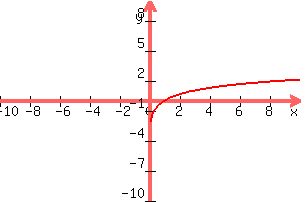Question 61836: Exponential and Logarithmic Functions
(1) Let f(z) = 3^z
(a) Find what value of z does f(z) = 81?
(b) For what value of z does f(z) = 1?
(2) Graph each of the following. Give coordinates of at least 3 points on each graph.
(a) y = 3^x
(b) y = logsub 3 x
(3) The population of a large U.S. city is growing according to the function P = 1,400,000(1.023)^t, where t is the number of years since 1990.
(a) What was the population in 1990?
(b) What will the population be in 2007 according to this formula?
(c) What does the value of 1.023 mean in the context of the problem?
Found 2 solutions by funmath, hotrodd:
Answer by funmath(2933)   (Show Source): (Show Source):
You can put this solution on YOUR website! Exponential and Logarithmic Functions
(1) Let f(z) = 3^z
(a) Find what value of z does f(z) = 81?
Method of like bases:



Same thing by taking the log of both sides but it requires a calculator.




 <--anytime you can't figure it out by making like bases you can do this. <--anytime you can't figure it out by making like bases you can do this.
:
(b) For what value of z does f(z) = 1?



Or you can take the log of both sides.
:
(2) Graph each of the following. Give coordinates of at least 3 points on each graph.
:
(a) y = 3^x
If x=-1
y=3^(-1) --> y=1/3 Plot (-1,1/3)
If x=0
y=3^0 --> y=1 Plot (0,1)
If x=1
y=3^1 --> y=3 Plot (1,3)

:
(b) y = logsub 3 x
x=3^y
If y=-1
x=3^(-1) --> x=1/3 Plot(1/3,-1)
If y=0
x=3^0 --> x=1 Plot(0,1)
If y=1
x=3^1 --> x=3 Plot (3,1)

:
(3) The population of a large U.S. city is growing according to the function P = 1,400,000(1.023)^t, where t is the number of years since 1990.
(a) What was the population in 1990?
t=0 in 1990
P=1,400,000(1.023)^0
P=1,400,000(1)=1,400,000
:
(b) What will the population be in 2007 according to this formula?
t=2007-1990=17
P=1,400,000(1.023)^(17)=2,060,700
:
(c) What does the value of 1.023 mean in the context of the problem?
:
The reason that I didn't answer this sooner is I'm not sure what vocabulary you need to use. Look it up in your book to be sure. It might be that it represents the population rate of growth.
:
Happy Calculating!!!
Answer by hotrodd(18)   (Show Source): (Show Source):
You can put this solution on YOUR website! (1a) z=4
(1b) z=0
(2a) (0,1) (1,3) (2,9) the graph should be like a half a U. once x is a negative, y just gets closer and closer to 0 but it never does.
(2b) im really sorry but i don't know what sub is unless it is the same as base. If it is then you can rewrite the equation as x=3^y.
(3,1) (9,2) (1,0). the graph will be a half of a U but on its side, opening to the right. it starts at right before (0,-1.5) and then keeps going up and to the right
(3a) 1,400,000
(3b) about 2060695 people
(3c) the rate at which the poplulation grows
|
|
|